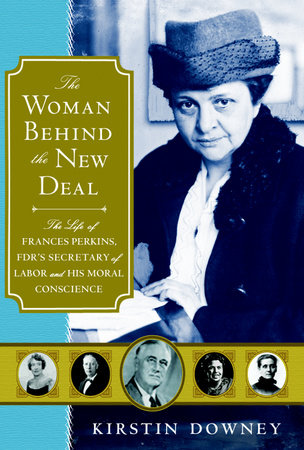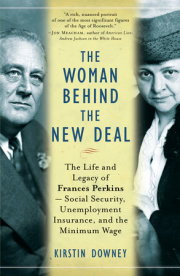Chapter 1
Childhood and Youth
Fannie Coralie Perkins knew by the age of ten that she would never be a conventional beauty, that unlike many women of her day she could not rely on physical attractiveness to open doors to her future. Her mother, Susan Bean Perkins, delivered the message when she took her daughter shopping for a hat. It was 1890, and the day's fashionable hats were slim and narrow, festooned with colorful ribbons and topped with flowers and feathers that added inches to a woman's height.
Susan Perkins passed by the pretty hats and pointed instead to a simple three-cornered tricorn style, similar to the ones worn by Revolutionary War soldiers.
"There, my dear, that is your hat," she told the girl in a matter-of-fact way. "You should always wear a hat something like this. You have a very broad face. It's broader between the two cheekbones than it is up at the top. Your head is narrower above the temples than it is at the cheek bones. Also, it lops off very suddenly into your chin. The result is you always need to have as much width in your hat as you have width in your cheek bones. Never let yourself get a hat that is narrower than your cheekbones, because it makes you look ridiculous."1
The hat would come to symbolize the plain, sturdy, and dependable woman who became Frances Perkins, and the mother's blunt advice to an awkward young girl left a lasting impression. From her earliest days, Fannie felt strangely out of step with the women of her time, her mother and sister included. She realized that rather than beauty, she must find other qualities and skills to set her apart, to help her achieve her idealistic goals. The dour-looking figure in the tricornered hat-the image seen throughout the years in filmstrips and photographs--disguised a woman whose intelligence, compassion, creative genius, and fierce loyalty made her an exceptional figure in modern American history.
Her mother's verdict on her looks, seared in memory for life, almost certainly overstated the case, for pictures from the time depict a child romantic in appearance, with long curls and a thoughtful look. Still it became fact that when people spoke of Frances Perkins, they almost always spoke of her character, not her outward appearance.
Fannie Perkins was born on April 10, 1880, on Beacon Hill, a few blocks from Boston Common, but her birthplace was almost a technicality. The place she considered home was where she spent her childhood summers, with her beloved grandmother at a homestead pioneered in the early 1700s by her great-great grandfather.
It was perched on a sweeping bend of the Damariscotta River in Newcastle, Maine, at a site filled with historic debris grown over into green meadows, sprawling over hundreds of acres to a place known as Perkins Point. Frances played amid the rubble pile left from the old stockade, erected in the years when families defended themselves against Indian attacks, and among the remains of discarded, half-baked bricks, reminders of the family's riverfront brick-making factory, which had made the family wealthy for a short time.
Perkins bricks had built many of the buildings in downtown Newcastle and as far away as Boston. The boom came in the 1840s. But the business failed a decade later after Boston financiers bought out the brick production of a number of local companies, including the Perkins operation, and merged them into a single corporation. The new business owners arranged for a large order from the Newcastle area to Halifax, Nova Scotia; the bricks were shipped, only to have the financiers disappear with the money. Every area brickyard went bankrupt. Afterward, all that remained of the once-prosperous Perkins business was the family home, built by their own hands, known as the Brick House.2
The family looked back at its glorious past while its present went to seed. By the 1870s, the decade before Fannie's birth, the family had turned to dairy farming for its sustenance. Her father, Frederick, blue-eyed, fine-boned, and refined, educated as a member of the upper class, had married Susan Bean, plump and down-to-earth, a woman from another old Maine family who was admired locally for her skills at animal husbandry. Soon Frederick was pining for a better life for himself and his family. He and Susan moved to Boston, where his brother Augustus had established a law practice. Frederick took a job as a retail clerk at a Boston department store. That was where Fannie was born, at a house on Joy Street.
But Frederick found his prospects in Boston unpromising. In 1882, he moved his family, this time to a fast-growing and gritty industrial city, Worcester, Massachusetts, some forty miles west of Boston. It was a place where a newcomer could afford to launch a business of his own. With a partner, George S. Butler, he opened a stationery and office supply store, prospering as the city's business base developed. In 1884, when Fannie was four years old, Frederick and Susan had a second child, Ethel.
Fannie grew up middle-class in Worcester, a shopkeeper's daughter. While her father built his business, they lived in boardinghouses before finally settling into a comfortable frame house in an upper-middle-class neighborhood. Staunch Congregationalists, they were faithful churchgoers.3
The family nonetheless thought of their ancestry as storied and heroic, and with some reason. The most dramatic family tales came from a paternal grandmother, Cynthia, who was born in 1809 and lived to be 101. Fannie's tightest family bond was to this woman, who had endless aphorisms about how people should behave when they faced adversity. In her adult life, Fannie frequently referred to her grandmother's witticisms, particularly when facing difficult decisions. She came to pride herself on the "Yankee" values they shared--self-reliance, democratic beliefs, tenacity, physical endurance, contempt for complainers, and a tendency to be close-mouthed, particularly about people and things she held most dear.
Their ancestors were Scotch and English Protestants who arrived in the colonies before 1680, landing first in the Pilgrim settlement of Scituate, Massachusetts, before making their way to Maine. Even Fannie's voice, with its rich and rather British-sounding New England accent, with long A's and dropped R's, carried faint echoes of that original Anglo-American heritage.
Wending their way through the Perkinses' family tree were strains of brilliance, traces of manic depression, and a propensity for acts of public altruism that cost the doers dearly--all key characteristics in Frances's personality as well. The family was particularly proud of one glorious and tragic ancestor, attorney James Otis, the incendiary Revolutionary War patriot who famously railed against "Taxation Without Representation" when he denounced that system as tyranny. Otis was clubbed in the head by a British officer--an injury from which he never fully recovered. Future president John Adams described Otis's disintegration with sadness, observing in his diary that Otis became "liable to great inequities of temper, sometimes in despondency, sometimes in rage."_4
The Civil War was also more than a chapter in a textbook to young Fannie--and provided even more proof of the risks of public participation in political life. Cynthia's cousin General Oliver Otis Howard visited the summer Fannie was fifteen. Howard had lost his right arm at the battle of Fair Oaks in Virginia, and Fannie was drafted into service as his scribe, a chore she found tedious at the time but that she would later vividly remember. Howard had founded Howard University in Washington and became chief of the Freedmen's Bureau, where his efforts on behalf of blacks led to criticism and censure by southern sympathizers. He was pilloried in Washington, falsely accused of misusing funds, and hounded from office, but the family admired him.5
Fannie was an exceptional child, unusually verbal and articulate, and she discovered that she had more in common with her father than with the other members of her immediate family. As a teenager, Fannie had little to say to her mother and sister. Her sister, Ethel, was a moody girl who was uninterested in academic pursuits. She took ill as a teenager, and completed high school only with the help of a tutor. She soon turned her attention to her marriage prospects. Her mother, basically kindly but plain-spoken and peppery to the point of abrasiveness, didn't grasp what a remarkable child she had in Fannie. She was stultifyingly conventional. Fannie's affection for both these women was dutiful rather than heartfelt.
Fannie's father must have been lonely in his marriage. Frederick, handsome and elegant, and Susan, portly and stolid, were ill suited to each other. Susan must have seemed a good choice of wife at the time of their marriage, when he was trying to make a living at dairy farming, but when he opted for another life in Massachusetts, the two seemed to have grown irrevocably apart. He clearly preferred spending time with Cynthia, his mother, who shared his interest in U.S. history, rather than with his wife, who occupied her free time with handicrafts, including painting pottery.
He focused particular attention on his precocious daughter, Fannie. He taught the child to read Greek when she was eight and he began to prepare her for college. At the time, only 3 percent of women went on to higher education. Fannie attended Worcester Classical High School, along with other affluent children, most of them boys. Students learned the traditional curriculum, including Latin and Greek.6
Fannie therefore had an unusual childhood for the time. It was a conservative era, with a string of Republican presidents predominating in politics and straightlaced Queen Victoria on the throne in England. Women were expected to be highly circumspect, protected, and closeted. Even Fannie's parents were conflicted about the way they were raising the girl. They were proud of her intelligence but ambivalent about what the future might hold for an educated woman.
Yet new ideas about giving women a broader social role were creeping into public consciousness, and Fannie's father was a fair-minded man. While on a business trip, he attended an evening lecture on women's suffrage delivered by Anna Howard Shaw, the militant physician and orator. He called it "magnificent" and came back home a convert to the idea that women should have the right to vote.7
Even as a girl Fannie showed qualities that would propel her forward in her adult life. When she was very young, she tended to be bashful in public, at times too timid to exchange a few words while returning a library book. She preferred to allow others to take center stage, but as she grew, she learned she could force herself to speak out and take the lead when it was needed. In an emergency she didn't hesitate to take control, showing her quick wit and calm, such as the time she staunched the blood flow from another child's wound by adeptly twisting a handkerchief into a tourniquet.
Sometimes she felt the urge to shock people and flout authority, and did it with some glee. In staid and middle-class Worcester, where people liked to think of themselves as upwardly mobile, Fannie proclaimed herself a Democrat, a party allied with the urban poor. Worcester, of course, was proudly Republican, as were Fannie's parents, and professing an allegiance with the lower classes drew a satisfyingly startled reaction from adults.8
From her earliest years, Fannie felt other people's pain acutely and lamented their suffering. Her mother, active in the church, frequently tended to the needs of poor neighbors and encouraged her daughter to befriend them as well. Fannie was also greatly affected by the tales brought back by foreign missionaries seeking to win converts to Christianity. Their descriptions of the plight of hungry children touched Fannie and inspired what she called a kind of "vicarious physical agony."_9
But while Fannie's parents were quick to provide a food basket for a hungry family, they also felt themselves superior to the poor. Fannie's parents weren't apt to blame misfortune on social injustice; they were more inclined to see drunkenness as causing poverty than poverty as causing drunkenness.
Fannie found herself pondering more deeply the reasons why some people were poor while others were not. Sometime during her teen or early adult years, she read a book that opened a "new world" to her. Written by Jacob Riis, a friend of progressive Republican president Theodore Roosevelt, it was called How the Other Half Lives. Riis, a police reporter for the New York Tribune and the Associated Press, wrote about life on New York's Lower East Side, where more than one hundred thousand people lived in homes not fit for human habitation and where thousands of abandoned children had no homes at all, surviving on scraps and by street theft. In one account, Riis described a child starving to death after his father grew too ill to work because of lead poisoning he contracted on the job.11
Riis's stories seemed almost unimaginable in quiet and smug Worcester. Writer Frederick Lewis Allen called the era a "time of complacency," once the depression of 1893 passed and populism died. Muckrakers had yet to begin disturbing the peace with their pungent observations. But changes were afoot, and among sensitive people like Frances, Riis's book found fertile ground.
While some recognized it and some did not, large fissures were developing in the nation's social fabric. The gap between rich and poor, urban and rural, grew wider every year of Fannie's childhood. America itself changed dramatically, shifting from an agricultural to an industrial nation, with millions of immigrants flooding into the country. The rapid influx began in 1880, the year Fannie was born. In 1900 about 449,000 immigrants arrived; by 1907, the number rose to 1.3 million. The influx stirred resentment in the native-born population. Fannie saw newcomers being abused by the native born, and it struck her as unjust that people who benefited from their labor would despise them. Fannie was developing an acute sense of social justice, and the treatment of immigrants drew her attention in the same way she had noticed the travails of the poor.12
Upon graduation from high school, Fannie enrolled in Mount Holyoke, the women's college near her Worcester home. Fannie could easily travel to and from the school by train. The eighteen-year-old soon fell in love with the college. Compared with workaday Worcester, the campus was idyllic. A small village green faced the school, with a fountain and a statue of a Civil War soldier. Across the street, the college's Gothic and Romanesque buildings rose amid broad and rolling lawns.
Mary Lyon, the school's founder, had had a spiritual mission, not just an educational one. She sought to prepare girls for lives of high purpose as missionaries and teachers; almost all her students were Protestants and were expected to attend religious services faithfully. Her motto: "Go forward, attempt great things, accomplish great things."
When Fannie entered Mount Holyoke, it had just begun calling itself a college after having been self-consciously labeled a seminary in its first years. Tuition and board cost $250 a year, a relatively modest sum, and the school required about fifty minutes of housework daily from each girl to defray expenses.13
Copyright © 2009 by Kirstin Downey. All rights reserved. No part of this excerpt may be reproduced or reprinted without permission in writing from the publisher.





